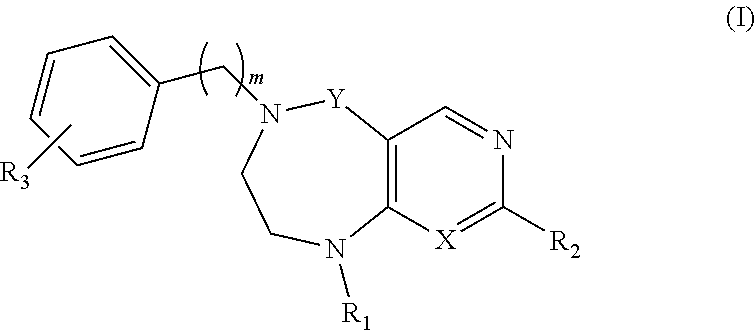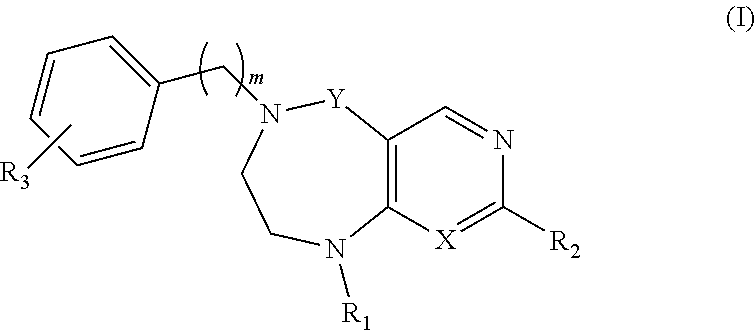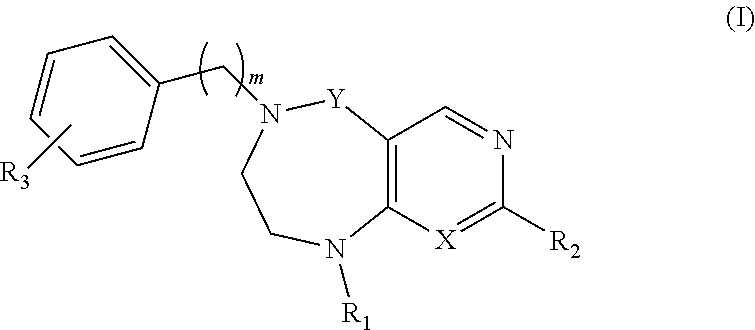Tetrahydropyrimidodiazepine and dihydropyridodiazepine compounds for treating pain and pain related conditions
a technology of pyrimidodiazepine and dihydropyridodiazepine, which is applied in the direction of drug compositions, organic chemistry, nervous disorders, etc., can solve the problems of unrelief for patients, significant productivity loss and socio-economic burden, and the safety ratio of patients is not optimal,
- Summary
- Abstract
- Description
- Claims
- Application Information
AI Technical Summary
Benefits of technology
Problems solved by technology
Method used
Image
Examples
examples
[0975]In the next preparation examples the preparation of both intermediates compounds as well as compounds according to the invention are disclosed.
[0976]The following abbreviations are used in the examples:
ACN: Acetonitrile
Anh: Anhydrous
Aq: Aqueous
[0977]BINAP: 2,2′-bis(diphenylphosphino)-1,1′-binaphthalene
Conc: Concentrated
CH: Cyclohexane
DCM: Dichloromethane
DCE: 1,2-Dichloroethane
[0978]DIAD: Diisopropyl azodicarboxylate
DIBAL: Diisobutylaluminium hydride
DIPEA: N,N-Diisopropylethylamine
DMA: N,N-Dimethylacetamide
DMSO: Dimethylsulfoxide
[0979]EtOAc: Ethyl acetate
EtOH: Ethanol
Ex: Example
h: Hour / s
[0980]HPLC: High-performance liquid chromatography
HRMS: High-resolution mass spectrometry
INT: Intermediate
MeOH: Methanol
[0981]MS: Mass spectrometry
Min: Minutes
Quant: Quantitative
Ret: Retention
[0982]rt: Room temperature
Sat: Saturated
[0983]TBAF: Tetrabutylammonium fluoride
TEA: Et3N, Triethylamine
[0984]TFA: Trifluoroacetic acid
THF: Tetrahydrofuran
[0985]XPhos: 2-Dicyclohexylphosphino-2′,4′,6′-triiso...
preparation examples
INT 1. tert-Butyl (3-(3-iodophenoxy)propyl)(methyl)carbamate
[0988]
[0989]To a solution of tert-butyl (3-hydroxypropyl)(methyl)carbamate (210 mg, 1.11 mmol) in THF (7 mL), 3-iodophenol (269 mg, 1.22 mmol) and PPh3 (320 mg, 1.22 mmol) were added. The mixture was cooled to 0° C. and then DIAD (247 mg, 1.22 mmol) was added dropwise. The reaction mixture was warmed slowly at rt and stirred for 16 h. The solvent was removed under vacuum and the residue was purified by flash chromatography, silica gel, gradient CH to 70% EtOAc to afford the title product (390 mg, 90% yield). ESI+-MS m / z, 414.0 (M+Na).
INT 2. tert-Butyl (R)-(3-((3-bromobenzyl)oxy)-3-phenyl propyl)(methyl) carbamate
[0990]
[0991]To a solution of tert-butyl (R)-(3-hydroxy-3-phenylpropyl)(methyl)carbamate (2.25 g, 8.48 mmol) in DMF (30 mL) cooled at 0° C., NaH (509 mg, 60% suspension in mineral oil, 12.72 mmol) was added and the solution was stirred at rt for 30 min. Then, the reaction mixture was cooled again at 0° C. and a solut...
example 1
l methyl(3-(3-(9-methyl-2-(methylthio)-5-oxo-5,7,8,9-tetrahydro-6H-pyrimido[4,5-e][1,4]diazepin-6-yl)phenoxy)-3-phenylpropyl) carbamate
[1032]
[1033]To a solution of 9-methyl-2-(methylthio)-6,7,8,9-tetrahydro-5H-pyrimido[4,5-e][1,4]diazepin-5-one (INT 10, 120 mg, 0.53 mmol) and tert-butyl (3-(3-iodophenoxy)-3-phenylpropyl)(methyl)carbamate (INT 4, 375 mg, 0.80 mmol) in dioxane (8 mL), CuI (31 mg, 0.16 mmol), K3PO4 (227 mg, 1.07 mmol) and N1,N2-dimethylethane-1,2-diamine (14 mg, 0.16 mmol) were added and the mixture was heated at 100° C. under Ar atmosphere for 16 h. The reaction mixture was cooled to rt and the solvent was removed under vacuum to give a crude product that was purified by flash chromatography, silica gel, gradient CH to 100% EtOAc, to afford the title compound (270 mg, 90% yield). ESI+-MS m / z, 586.2 (M+Na).
[1034]This method was used for the preparation of Ex 2-61 using suitable starting materials:
Meth-od / RetEXStructureChemical name1H-NMR (ppm)(min)MS2tert-butyl (R)-met...
PUM
| Property | Measurement | Unit |
|---|---|---|
| Force | aaaaa | aaaaa |
| Volume | aaaaa | aaaaa |
| Volume | aaaaa | aaaaa |
Abstract
Description
Claims
Application Information
 Login to View More
Login to View More - R&D
- Intellectual Property
- Life Sciences
- Materials
- Tech Scout
- Unparalleled Data Quality
- Higher Quality Content
- 60% Fewer Hallucinations
Browse by: Latest US Patents, China's latest patents, Technical Efficacy Thesaurus, Application Domain, Technology Topic, Popular Technical Reports.
© 2025 PatSnap. All rights reserved.Legal|Privacy policy|Modern Slavery Act Transparency Statement|Sitemap|About US| Contact US: help@patsnap.com



